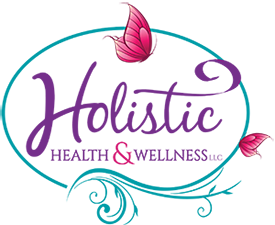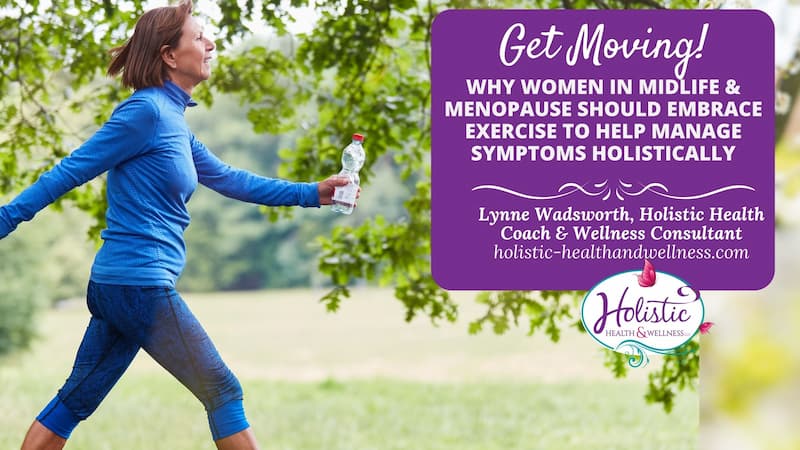Getting Started with Exercise
As a woman in midlife and menopause, you may be regularly bombarded by ads for prescription medication and conventional medicine interventions like hormone replacement therapy (HRT). Ever mindful of potential harsh side effects, you may be wondering if there are natural, holistic methods to reduce your symptoms.
Take heart!
In addition to herbal tinctures, holistic therapies like acupuncture, and lifestyle changes like diet and better sleep, there is another natural solution: exercise.
Here’s how regular exercise helps relieve menopause symptoms in women in midlife and menopause, as well as some tips to get started:
Exercise affects women in midlife and menopause physically, as well as mentally and emotionally. Humans were meant to be physically active. Inactivity can contribute to heart ailments, obesity, anxiety and depression. 1
The benefits of exercise are innumerable. For example, physical therapists use it in rehabilitation programs; some people prone to depression and anxiety take up running to lift their moods and regulate their emotions; and, of course, exercise contributes to weight loss and fitness. 2
The 5 Elements of Physical Fitness
So, which elements contribute to physical fitness?
This holistic approach can be broken down into 5 parts:
- Flexibility – the range of movement possible in the joints.
- Muscular strength – measured in the amount of force it takes to contract a muscle
- Muscular endurance – the ability of the muscle, or group of muscles, to perform a task for a certain period of time
- Cardiovascular-respiratory fitness – involves the body’s capacity to take oxygen into the bloodstream and it determines how well the lungs, heart, veins and arteries supply oxygen to the cells
- Balance – the body’s ability to maintain a stable posture and control movements. 3
How Exercise Naturally Eases the Symptoms of Menopause in Women in Midlife

So, are there any exercises to specifically target the emotional, mental and physical needs of women in midlife and menopause? Look no further, because here are some expert-recommended tips:
- Regular outdoor exercise and plenty of sleep will help ease menopausal symptoms 4
- Regular walking helps prevent osteoporosis 5
- Exercise may help reduce the frequency and severity of hot flashes
- Regular exercise improves mood, bone health, and the cardiovascular system
- Regular physical exercise is a key component of menopause care 6
The health benefits of regular exercise during menopause include:
- Decreased blood cholesterol levels
- Decreased bone loss
- Improved ability to deal with stress
- Improved circulation
- Improved heart function
- Improved oxygen and nutrient utilization of all tissues
- Increased endurance and energy levels
- Increased self esteem and mood
- Reduce blood pressure
- Relief from hot flashes 7
What kind of exercises do experts recommend?

There’s a variety of exercises perfect for women in midlife to help relieve the symptoms of menopause.
To get started, here are five exercises perfect for women in midlife and menopause:
Walking. This requires no special equipment and can be done outdoors in a park or on a city sidewalk. The benefits of walking in fresh air include cleaning your lungs, boosting your mood, lowering your heart rate and improving digestion 8 In addition, walking in a beautiful environment like a nature trail can produce an energy and mood boost as well as a sense of peace and wonder. If you’re not used to exercise, you can start by doing it for several minutes a day, then gradually increase. Walking at least 30 minutes a day can decrease the risk of heart attacks, stroke, hypertension, some cancers, osteoporosis, depression and obesity. 9
Tai Chi. This is an ancient Chinese martial art. Although originally developed for combat and self-defense, Tai Chi has evolved into a form of exercise. It can be considered a low-impact and gentle form of exercise wherein people perform a series of deliberate and flowing motions while focusing on slow, deep breaths. Tai Chi is helpful for people with osteoarthritis. It can improve lower limb muscles, build core strength and improve balance, posture and flexibility 10 How do you get started in Tai Chi? You can look up instructions online from a trusted source. Better yet, you an find instructional videos online, such as on YouTube. You can even enroll in a Tai Chi class near you.
Aerobics. Aerobics means “with oxygen,” and the key is in oxygen consumption. Aerobic exercise increases the volume of air in the body, thereby improving over time the efficiency and capacity of the lungs, heart, veins and arteries to bring in and and deliver oxygen to the cells. Jogging, swimming, cycling and jumping rope are some good examples. Another benefit is that they all can be done outdoors.11
Strength training. Also known as weight training or resistance training, this type of exercise improves physical strength. It can incorporate bodyweight exercises (e.g. push ups, pull ups, etc.), isometrics (which means holding a position under tension, such as planks) and weight-lifting. An October 2023 study concluded that strength training can counteract the age and menopause-related loss of muscle mass and strength in middle-aged women (ages 40 – 60). 12
Yoga. A segment of Hindu philosophy, Yoga can be broken down into two categories: the meditative (Karma, Jnana, Bhakti and Raja yoga) and the physical (Hatha yoga). Physical yoga includes getting in and out of body postures called asanas, breathing exercises and relaxation techniques. These can improve physical and mental discipline. 13 Yoga classes are widely available through health clubs, community centers, and universities. As a non-aerobic stretching exercise, yoga tones muscles that balance all parts of the body, increases flexibility and can improve chronic back pain. It also benefits the nervous system by leading to deep relaxation and reducing stress. In addition to improving physical fitness, yoga can help calm people and balance them emotionally and spiritually. 14
Connecting the mind and body to achieve balance

Experts say exercise can connect the mind and body. This is especially beneficial for women in midlife and menopause.
Here’s how:
Over time, studies and experience have proven the link between mental and physical health. Meditation and other mind-body practices such as yoga, tai chi and mindfulness are excellent choices. These continue to grow in popularity and emerging research shows that there are neurobiologic, physiologic, and genomic changes associated with mind-body practices, particularly meditation. Mind-body practices activate specific brain regions and suppress stress-induced inflammatory pathways 15
In Conclusion
Both vigorous and gentle exercise provide a holistic, natural way for women in midlife and menopause to reduce uncomfortable symptoms as their estrogen levels drop and their bodies change.
This includes decreased bone loss, decreased cholesterol levels, fewer hot flashes, better self-esteem, better balance and relaxation, among many other benefits. Be kind to yourself – skip the doctor and medication and try to nurture your body through regular exercise. Your body and mind will thank you for it!
Looking for a better way to incorporate exercise and movement into your daily/weekly routine? Are you feeling a little lost and not sure of the best way for you to move forward? Let’s chat. Book a 20-minute consultation call with me and let’s bet moving.

References
- “The Holistic Health Lifebook,” by the Berkeley Holistic Health Center (page 105)
- “The Holistic Health Lifebook,” by the Berkeley Holistic Health Center (page 105)
- “The Holistic Health Lifebook,” by the Berkeley Holistic Health Center (page 105 – 106)
- “Encyclopedia of Natural Healing,” Z. Rona, MD, et al page 946)
- “Encyclopedia of Natural Healing,” page 943
- “Encyclopedia of Natural Medicine,” page 642
- “Encyclopedia of Natural Medicine,” page 642 – 643)
- Lindsey Grossman https://stmarysmaine.com/
- MedlinePlus [Internet].: Linda J. Vorvick, MD, Clinical Professor, Department of Family Medicine, UW Medicine, School of Medicine, University of Washington, Seattle, WA. Also reviewed by David C. Dugdale, MD, Medical Director, Brenda Conaway, Editorial Director, and the A.D.A.M. Editorial team]. Available from: https://medlineplus.gov/)
- drweil.com, by Andrew Weil, M.D., integrative physician
- “The Holistic Health Lifebook,” page 106
- Resistance training alters body composition in middle-aged women depending on menopause – A 20-week control trial BMC Women’s Health https://doi.org/10.1186/s12905-023-02671-y
- “The Holistic Health Lifebook,” page 106
- drweil.com, Andrew Weil, M.D. integrative physician
15 (N Engl J Med. 2020 Apr 9;382(15):1390–1391. doi: 10.1056/NEJMp1917461)



